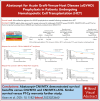Abatacept for acute graft-versus-host disease prophylaxis after unrelated donor hematopoietic cell transplantation
- PMID: 39028876
- PMCID: PMC11530361
- DOI: 10.1182/blood.2023023660
Abatacept for acute graft-versus-host disease prophylaxis after unrelated donor hematopoietic cell transplantation
Abstract
Abatacept plus calcineurin inhibitors/methotrexate (CNI/MTX) is the first US Food and Drug Administration (FDA)-approved regimen for acute graft-versus-host disease (aGVHD) prophylaxis during unrelated-donor hematopoietic cell transplantation (URD-HCT). Using Center for International Blood and Marrow Transplant Research data, we investigated its impact in patients receiving 7/8 HLA-mismatched unrelated donor (MMUD) or 8/8 HLA-matched unrelated donor (MUD) URD-HCT between 2011 and 2018. Primary outcomes included day-180, 1-year, and 2-year overall survival (OS) and relapse-free survival (RFS) for abatacept + CNI/MTX vs CNI/MTX, CNI/MTX + antithymocyte globulin (ATG), and posttransplant cyclophosphamide-based prophylaxis (PT-Cy). For 7/8 MMUDs, day-180 OS (primary end point supporting FDA approval) was significantly higher for abatacept + CNI/MTX vs CNI/MTX (98% vs 75%; P = .0028). Two-year RFS was significantly higher for abatacept + CNI/MTX vs CNI/MTX (74% vs 49%; P = .0098) and CNI/MTX + ATG (77% vs 35%; P = .0002), and similar vs PT-Cy (72% vs 56%; P = .1058). For 8/8 MUDs, 2-year RFS for abatacept + CNI/MTX was numerically higher vs CNI/MTX (63% vs 52%; P = .1497), with an improved hazard ratio (HR) of 0.46 (0.25-0.86), and vs CNI/MTX + ATG (66% vs 55%; P = .1193; HR, 0.39 [0.21-0.73]), and was similar vs PT-Cy (68% vs 57%; P = .2356; HR, 0.54 [0.26-1.11]). For 7/8 MMUD and 8/8 MUD recipients, abatacept + CNI/MTX prophylaxis improved survival outcomes vs CNI/MTX and CNI/MTX + ATG; outcomes were similar to PT-Cy-based regimens. Abatacept + CNI/MTX may facilitate unrelated donor pool expansion for HCT.
© 2024 American Society of Hematology. Published by Elsevier Inc. All rights are reserved, including those for text and data mining, AI training, and similar technologies.
Conflict of interest statement
Conflict-of-interest disclosure: L.S.K. is on the scientific advisory board for Mammoth Biosciences and HiFiBio; received research funding from Magenta Therapeutics, Tessera Therapeutics, Novartis, EMD Serono, Gilead Pharmaceuticals, and Regeneron Pharmaceuticals; received consulting fees from Vertex; received grants/personal fees from Bristol Myers Squibb; and reports royalties/partial funding for this study from Bristol Myers Squibb. L.S.K.’s conflict-of-interest with Bristol Myers Squibb is managed under an agreement with Harvard Medical School. L.J.B. received research collaborations with Astellas, bluebird bio, Gamida Cell, Kyowa Kirin, Mesoblast, Sanofi, and Vertex; and received a research contract through her institution for this study with Bristol Myers Squibb. S.E.C. and M.P. are employees and shareholders of Bristol Myers Squibb. R.K. is a current employee of Cytel; was on a work-share agreement with Bristol Myers Squibb during the time of analysis; and is a shareholder of Bristol Myers Squibb. A.L. received a medical writing support and a research contract for this study with Bristol Myers Squibb. M.Q. received honoraria from Novartis and Vertex; and received medical writing support from Bristol Myers Squibb. X.-Y.T. received support and payment to their institution from Bristol Myers Squibb; and is an immediate family member of an employee and shareholder of Kite Pharma. B.G. received consulting fees from WebMD, LLC; and is a former employee of (within 36 months) and shareholder of Bristol Myers Squibb. M.C.P. received research support from Bristol Myers Squibb; received grants/contracts from Bristol Myers Squibb, Kite Pharma, Novartis, and Janssen; and reports payments/honoraria for lectures from Kite Pharma. K.L., T.D.K., and A.G.-C. are former Bristol Myers Squibb employees (within 36 months) and shareholders of Bristol Myers Squibb. The remaining authors declare no competing financial interests.
Figures



Comment in
-
Abatacept vs PT-Cy for GVHD prophylaxis.Blood. 2024 Oct 24;144(17):1762-1764. doi: 10.1182/blood.2024026116. Blood. 2024. PMID: 39446374 No abstract available.
References
-
- Lee SJ, Klein J, Haagenson M, et al. High-resolution donor-recipient HLA matching contributes to the success of unrelated donor marrow transplantation. Blood. 2007;110(13):4576–4583. - PubMed
Publication types
MeSH terms
Substances
Grants and funding
LinkOut - more resources
Full Text Sources
Medical
Research Materials

